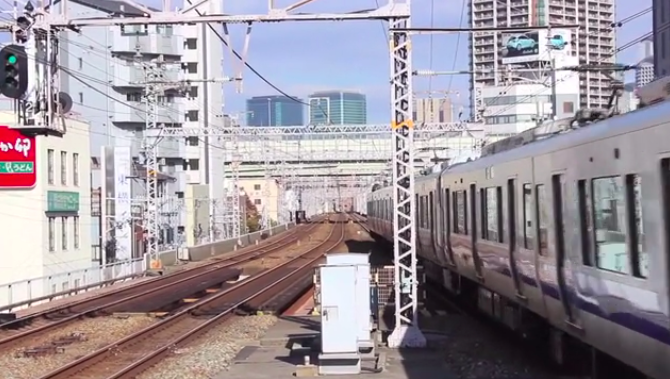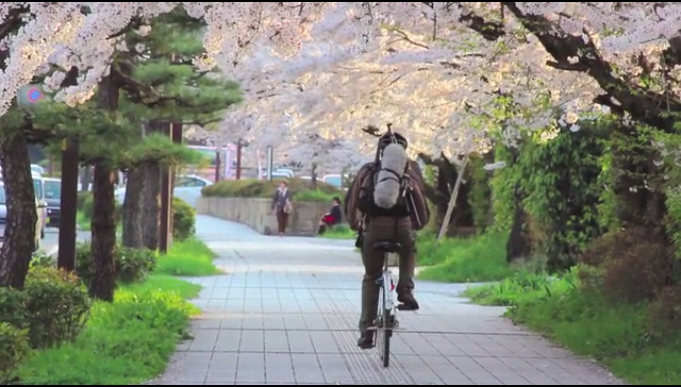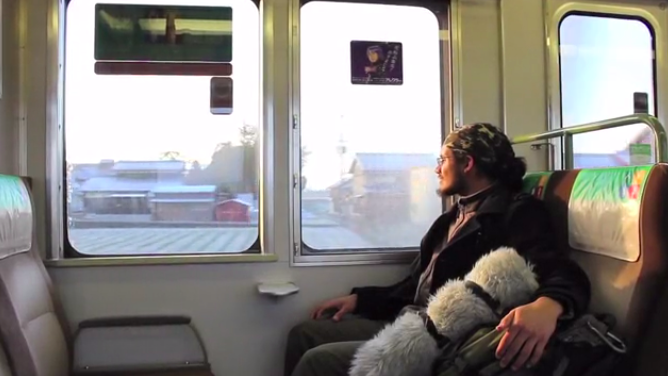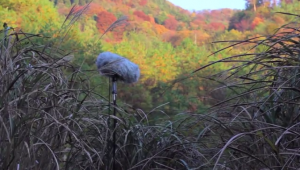At the time of writing, recent graduate and field recordist Chris Trevino has a Kickstarter campaign called “The Japan Sound Effect Collection” which he plans to be a collection of ambiences, train passes, and walla. Chris was kind enough to answer a few questions about his current campaign.
Designing Sound: Tell us a little bit about your own background in sound and field recording.
Chris Trevino: I was enraptured at a young age by the games that were coming out of Japan in the 90s. The music of Nobuo Uematsu (Final Fantasy Series) and Yasunori Mitsuda (Chrono Trigger/Cross) gave me both the game and Japan bugs. These games inspired me to take up the tenor saxophone and then later choir when I was younger and made me want to be a game composer.
I first started my undergraduate as an anthropology major, because of my love of cultures, but quickly discovered that I loved the ideas but was not passionate about the work. At the end of my first year, still dreaming of game music, I took summer music composition classes and my first sound design class. Needless to say, I got hooked.
Since then, I’ve sound designed a handful of theater productions and have done a lot of field recording on my own. In the summers of 2012/13, I trained with Ric Viers at The Detroit Chop Shop. While there, I helped record and edit four commercial sound effects libraries for BlastwaveFX. I started the Japan collection in Fall of 2013 while I was studying Japanese at a language center in Japan.
DS: What made you choose Japan as a subject for field recording?
CT: Choosing Japan as a subject for field recording was a natural choice given how much Japanese games influenced me when I was younger. When I was accepted into the language center in Japan, I knew that I needed to do as much recordings there as I could.
DS: What makes the trains and crowds of Japan unique?
CT: In crowd recordings, the ideal walla doesn’t have distinct words and noticeably repetitive patterns. We aim to capture the energy of a social space without capturing individuals. There are three things that create this social energy: the acoustic space, the number of people present and their voices.
Every language has their own distinct rhythm and pitches which change the energy of a social space. Dialects and accents further change this energy. For those familiar with the United States, consider the difference between in how a bar full of people in the Deep South of Louisiana would sound compared to one in Boston. While we may not be able to discern the individuals within walla groups in these settings, we would perceive a different feeling based off of how the people are speaking.
How important this is really depends on your production’s design goals and intended audience. Productions that attempt to be historically or culturally accurate, or are geared towards an audience that would be aware of these differences, need to be much more particular on using region-authentic walla.
In Japan, there are several major dialect groups. The classic ones being Kansai-ben (spoken in the Kansai region: notably Osaka/Kyoto) and Tokyo-ben (spoken in Tokyo and many regions in Northern Japan).
Japanese dialects use different words, grammar structures and rhythm patterns. For instance, in casual settings, the verb “to not understand” is “wakaranai” in Tokyo-ben and “wakarahen” in Kansai-ben. There are many differences beyond just this, as well. Using Kansai-ben walla in a Tokyo-ben setting could undermine your production by breaking aural continuity. This is the equivalent of using a Louisiana drawl walla in a Boston bar.
As for trains, the sheer variety of Japanese trains & subways is worthy of note. There are 6 regional Japan Rail companies that service different parts of Japan, all of which use a combination of different trains. On top of this, there are 16 major private rail companies with their own kinds of trains, 6 major cities with different subways systems, nation-wide freight transit and a multitude of smaller rail companies throughout the country. And let’s not forget the 12 or so different bullet trains currently in service. On top of this, there are different kinds of announcements both on-train and in the train station depending on which company you’re riding with and what region you’re in.
DS: Are there some “must have” trains or regions (for walla) that you are targeting?
CT: I’d like to record some of the older trains, like the E3 Series mini-shinkansen (mini bullet train), that are starting to be phased out. The Chubu and Tohoku regions seem to have a great deal of aging train infrastructure that is in the process of being replaced and I’d like to document some of it before it disappears. In terms of walla, I’d like to get more school-aged walla recordings as well as a wider variety of Kansai-ben and Tokyo-ben wallas.
DS: Your Kickstarter video mentions that there are no commercially available sounds from Japan like yours. To be fair: The Sound Librarian, Nature Sounds Society Japan, among others have been recording in Japan and distributing their work for quite some time. Would it be more accurate to say this library won’t necessarily be incredibly singularly unique, but instead will be easier for Western audio professionals to obtain who are used to the new a la carte indie sfx library system? There are already a decent amount of field recordings of Japan out; what will make yours unique?
CT: The vision of this collection is what sets it apart from other field recordings from Japan. By concentrating on regional differences at the project’s onset, this collection appeals to multiple audiences. Productions that require faithful, discrete recordings from specific regions of Japan will be satisfied with this library. The sheer variety of sounds in this collection, though, also benefits people who are broadly looking for sounds from Japan as well as people who are seeking novel sounds.
While there are quite a number of field recordings from Japan, many of the collections available have issues of accessibility, quality, and breadth of work/variation. One of the biggest issues for accessibility is the language gap. Japanese recordists are doing impressive work, but most of their recordings are only available on Japanese language-only websites. There are some recordists, like Hide Aoki, who have released libraries on English websites. His currently available work is limited to sounds in the Tokyo area, though.
On the high end of English-speaking recordists who have recorded in Japan, there are people like The Sound Librarian, Stephan Schutze, and Tim Prebble of Hiss and A Roar. Stephan Schutze includes many recordings from Japan in his Foundation Library. The Foundation Library, though, is geared towards being a general workhorse library and costs $1800 (rightfully so), and is recorded at 16-bit/48KHz. Knowing Stephan’s work, these sounds are beautifully recorded; they are much harder to access, though, because they’re only included in his flagship library. Tim Prebble did extensive recordings in Japan for the movie “The Emperor” and continues to record there. Right now, he only has one library that is specifically advertised as from Japan, and that is recordings of monkeys on the island of Shidoshima.
There are also Japanese recordings on online sound catalogues like Sounddog and FreeSound. These sites are really great for one off sound effects but can pose challenges for those who are looking for variation or multiple perspectives. FreeSound, especially, can have considerable variation in recording quality. The actual authenticity of the sounds on FreeSound can be suspect as well, considering that the website requires minimal identification.
My collection fills in the market gap for English-speaking professionals of a general library of sounds from Japan. I can’t hope to record as in-depth a library as Japan-natives are able to. What I can offer, though, is a glimpse into the sonic world of Japan. In my eyes, this project is just as much a cultural archive as it is a creative work.
DS: You’ve got JrF mics on your gear list? How will you be using those on the trip?
CT: JrF’s induction coil pick-up is something that Ben Minto, one of EA DICE’s audio directors, turned me onto in a conversation we had at GDC last year. These pick-ups are able to capture very isolated sounds from electronics. I want to experiment with capturing sounds from places like the servos on train doors and a variety of consumer electronics. While these sounds may be more esoteric, recording older and domestic-only electronics could make unique and valuable design tools.
Much like like the induction coil, JrF’s C-series contact microphone will enable me to record multiple and different perspectives. For instance, simultaneously recording a train passby with my NTG-3 shotgun microphone and the C-series contact mic will give the me, or the end user, greater flexibility in mixing the final sound effect.
DS: Your principal mics are the NT4 and NTG-3s. What made you decide to take these with you on your trip? Looking at your gear list perhaps you should be sponsored by Rode!
CT: Hah! Perhaps I should be sponsored by them. That’d certainly make some logistics of this project easier. Ultimately, though, I firmly believe that the best microphone for the job is the one you have. Rode microphones fit the bill for what I’m able to do.
As someone who is early in his career, I find it invaluable to have an adaptable kit of microphones. Rode microphones balance quality and price very well. I’ve been known to subject my gear to some extreme conditions, and Rode mics have always delivered.
The only time I’ve ever had an issue with one of their mics was when I was recording on top of an ice shelf in -30F windchill weather. I don’t do that very often.
DS: I have an NTG-3 as well and love its durability. Obviously it will change from subject to subject but how are you planning on using all 3 NTG-3s? In multiple perspectives or a possible stereo configuration?
CT: With only two blimps at my disposal, I can only really use two of the NTG-3s at a time while recording outdoors. The third NTG-3 is primarily for redundancy. I plan to primarily use them together to capture multiple perspectives of the same event, though I can see using them in a spaced pair to capture train approach/departures. The NT4 and DR-40 will be my primary stereo workhorses, though.
DS: Your recording schedule has you going through Japan for most of Spring. Are you worried about insect noise creeping into your crowds and ambiences?
CT: I don’t foresee insect noise being too great of an issue. I’ll be doing most of my traveling in southern/central Japan in March. I spent September-April living near Kyoto in central Japan. Insects were starting to become present again there in March, but were not a major concern in urban areas. Part of this collection is recording nature sounds, so capturing that progression of insect creep is something that I want to record too.
Hokkaido, where I’m staying in April & May, has a climate very similar to where I’m from in the United State’s Northern Midwest; in other words, it stays colder longer there. This should make it ideal for me to have very little insects for at least the first couple weeks in April. For better or worse, I won’t be in the Japan during cicada season, which is one of the biggest insect noise concerns in Japan.
 DS: How much “cleaning” if any are you planning on doing to the library with something like iZotope RX to keep focus of a recording on what you intended to capture?
DS: How much “cleaning” if any are you planning on doing to the library with something like iZotope RX to keep focus of a recording on what you intended to capture?
CT: My philosophy is to record as cleanly as possible and do as little post-processing as practical. With that said, though, the nature of guerilla recording presents a challenge to achieve that ideal. It’s very rare to be able to control circumstances when you’re out in the world. The bulk of my cleaning process will consist of crossfades and extremely delicate EQing. I’m hesitant to use RX in all but extreme circumstances because I feel that many of the things that RX fixes are things that you can prevent through using proper technique in the field.
DS: You yourself have impressively backed 26 Kickstarter projects. What made you decide to use Kickstarter for distributing this project?
CT: I love Kickstarter. It helps equalize the marketplace, and allows independents to reach an audience to realize their dreams. As someone who comes from a very rural area, Kickstarter gives me the opportunity to present myself to our larger global sound community. I simply could not accomplish a project this ambitious without everyone else’s help. Kickstarter sound effects libraries are still a relatively new thing, and I am overjoyed that our community has been very supportive thus far.
Coincidentally enough, three of the four successful Kickstarter sound effects libraries prior to the Japan Sound Collection were created by friends of mine from Michigan Technological University. In 2012, Dave Nichols did his dyno recording session on Kickstarter, which helped launch his career into game audio. Then in 2013 and 2014, Ben Jaszczak and his team successfully funded both the Free Firearms and Free Medieval Weapons libraries via Kickstarter. I was actually slated to help Ben on the firearms library, but ended up being in Japan when they did it.
The support from my friends who have done Kickstarter projects has been invaluable in my decision to do this project on Kickstarter. Karen Collins, who recently did the “Beep” game audio documentary, was especially influential in the process.
You can find the ongoing Kickstarter campaign here. You can also find the collection on Facebook or follow Chris on Twitter.




I like it when I stumble upon interviews with people I went to school with! Nice one Chris!